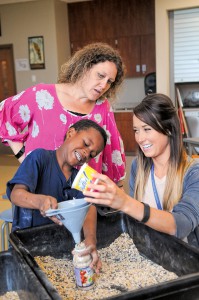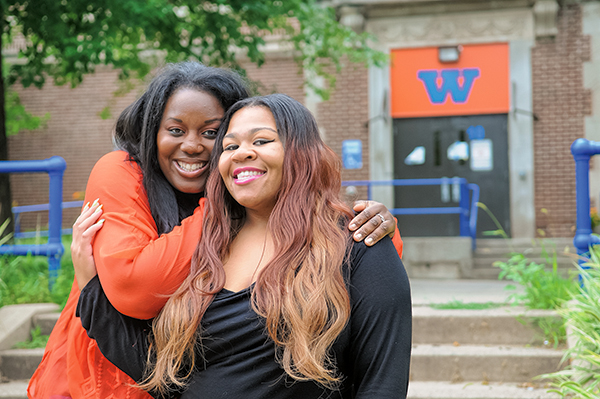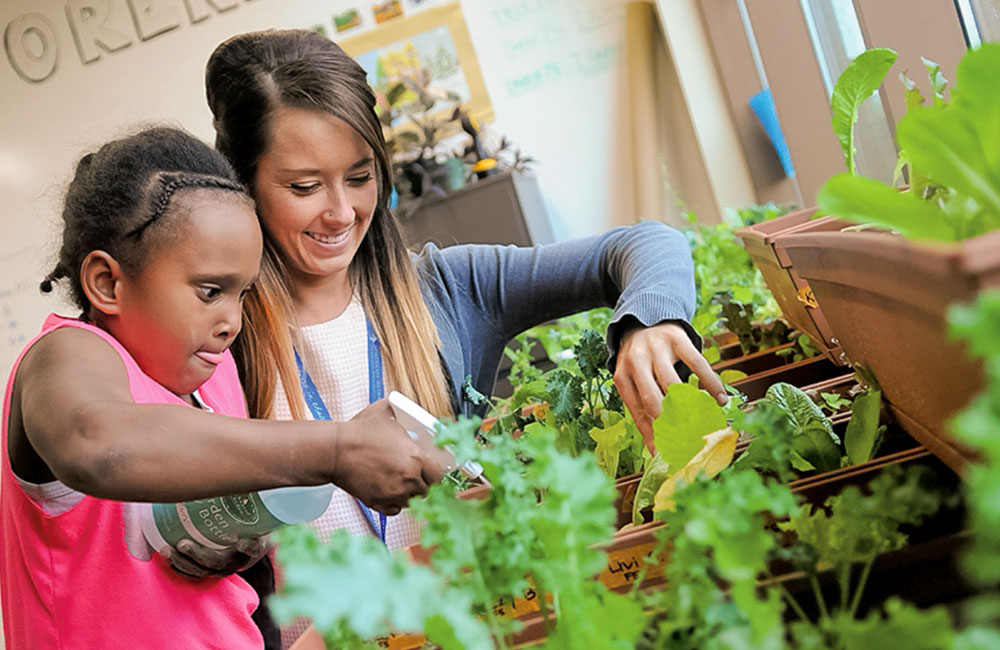Karner Blue Education Center in Circle Pines, Minnesota, is a window on the future of special education. Only blocks from a busy freeway, its many windows look out on a wide meadow full of trees.
Inside this school named after an endangered butterfly, the spaces are spare and soothing, in colors of earth and sky. Karner Blue contains four areas or communities inspired by outdoor themes—Forest, Lake, River, and Prairie. One community serves only autism spectrum disorder (ASD) students, another a combination of ASD and emotional and behavioral disorders (EBD). All the spaces are secure, and there’s a separate area called the Burroughs for students when it’s unsafe for them to stay in the classroom.
Brittany Beaudette is an educational assistant in the K–5 River community, whose students have severe behavioral problems. Beaudette came to special education after completing a bachelor’s degree in psychology. She was hired as an EA by Northeast Metro 916 Intermediate School District in 2013 and worked in the field only one year before moving to the new school when it opened last fall.
In teacher Kelly Gahie’s classroom, Beaudette works with six children, including a boy she followed from her first location to Karner Blue.
“This year he’s like a different kid,” she says.

The setting is different, and so is Beaudette. During 2014–15, she completed the first half of a two-year U of M master’s degree program in special education that is preparing her for teacher licensure in EBD. But she doesn’t drive to the U—the U comes to District 916.
Reflecting on the decision to enter the master’s program, Beaudette says at first she wasn’t sure. It was a big commitment in a year of big changes. But she decided to go for it and is glad she did. She credits Gahie, whose background is in social work as well as special education, with welcoming her ideas and her program faculty into the classroom.
She credits the University program with helping her to build her skills and gain the knowledge and confidence to become a teacher.
“The intense coaching and supervision, the opportunity for classroom teaching and getting involved in such areas as due process and intervention plans—every single day—make the format of this program ideal,” says Beaudette.
A call for help
Minnesota’s teacher shortage in special education is serious and growing, and Megan McAllister knows it firsthand. She is the staffing coordinator for District 916, which serves 12 member districts from Stillwater and Forest Lake to Fridley and Cottage Grove. It is one of Minnesota’s three such districts dedicated to providing highly specialized educational programs and services to students, families, and school districts in a cost-effective way.
Last year, for example, District 916 served 400 students with EBD and ASD referred by their home school districts. The number of students who need special education services has been growing so rapidly that 916 was able to make a clear case for building Karner Blue, designed specifically for that purpose.
Building schools is hard but staffing them is even harder. In 2013, McAllister didn’t know how the district could keep up with its EBD staffing needs. One bright spot was the high quality of its educational assistants, like Brittany Beaudette, who loved their jobs and excelled. But it was almost impossible for them to go back to school to get the degree and licensure they needed to advance into the teaching profession, and doing so would take them out of their valued positions.
Then McAllister got the name of educational psychology professor Jennifer McComas at the U.
“I called her and basically said, ‘Help! Can you help us?’” McAllister says. Was there any way the U could bring its master’s program in emotional and behavioral disorders to the district so educational assistants could get licensure while staying in their jobs?

McComas responded immediately. She started working out a plan to deliver the existing master’s degree curriculum in a combination of formats—off-site lecture, online, and clinical observations—to the district. The plan had to get approval from the Minnesota Board of Teaching, and by the time it did, on April 11, 2014, word had spread.
When fall semester began last September, the pilot cohort of new U students included 23 working professionals in five school districts—Intermediate Districts 916 and 917, Minneapolis Public Schools, Mounds View, and North St. Paul–Maplewood–Oakdale. Each had to apply to and be recommended by their district and then apply and be accepted into the University’s two-year program.
Strength of a cohort
Monday through Friday during the past school year, all 23 master’s students went to work at jobs that many would consider among the most demanding anywhere. They work with children and youth with EBD who are at great risk of hurting themselves and others, who have been removed from general education classrooms and schools. In EBD classrooms, educational assistants support the licensed teacher, who at any time may need to leave the room with a student who has lost control.
On Wednesday nights, the cohort came together for six hours of off-site classroom instruction at Capitol View Education Center in Little Canada. There they experienced interactive learning tailored to their goals. For large portions of the evening, they took on the roles of their own students, experiencing the methods they would take back to their classrooms.
One night in April, for example, instructor Dave Edwards took them through a seventh-grade-level lesson on three quatrains by Shakespeare. Edwards modeled giving explicit instructions, moving step by step and using proven methods to develop EBD students’ skills in processing verbal directions, writing, speaking, and controlling impulses. He invited discussion that allowed the class to bring examples and brainstorm how to address the struggles of particular students.
“Sure, I’m tired when I get here,” said one student over a break, “but every Wednesday as we’re going through examples, I am thinking of something that happened that day and how this could work or could be applied. And the next day, I have something to bring back and try in the classroom, right there, right away, so I’m getting energy from that.”
The rest of the weeknights and weekends, the students completed homework and online courses. And almost every week, they prepared for a visit from their U instructors, who observed and coached them through a variety of new activities and methods.
“When we came together in the fall, it was intimidating,” says Beaudette. “For example, I was coming from work in a beautiful new school and some of us [were coming] from schools with metal detectors. But we all have experience, we know what we’re getting into, and all 23 of us are passionate about what we do. And we felt supported by Professor McComas, our instructor, and each other.”
The cohort model made the most of the knowledge, experience, and perspectives they all brought to the classroom every Wednesday.
“Getting feedback on a weekly basis is invaluable, and there are so many schools represented in the cohort to build off of and learn from,” says Tre Lewis. He earned his B.A. in criminal justice at George Washington University and now works with high school students at Reach Academy in Mounds View. “Here you have like-minded people who still have a lot of different ways of thinking—it helps build your knowledge.”
“We had some assumptions when we started,” says GinaMarie Theesfeld from Minneapolis Public Schools. “Talk about diversity—culturally, ethnically, socioeconomically, suburbs and heart of the city, men and women.”
A gift to students
Theesfeld came to special education by chance. With a background in criminal justice and law, she took a job in a group home while starting her own family and working part time. A friend observed that she would do well in schools. Theesfeld was hired as a special education assistant with sixth-graders at Sanford Middle School in Minneapolis and then moved with them as they advanced to Washburn High School. Now she is watching those students graduate. Theesfeld is one of the rare staff members who has helped students move successfully from highly restrictive to less restrictive levels of EBD services and even back to general ed classrooms.

“We need more people in this field and more who are passionate about these students,” she says.
After six years as an educational assistant, Theesfeld wanted more. She even thought about going to law school. Then her supervisor told her about the new U master’s program and she saw an opportunity to focus on becoming a teacher.
Like many of her peers in the cohort, Theesfeld has juggled her job, family life, and school. But the balance has become part of her lesson plan.
“This past year, watching someone like me work, be a parent, and be a student lets my students see what that looks like for their future selves,” says Theesfeld. “Your students get to see you with integrity—that is important.”
The program also gives educational assistants a strong message, she adds.
“It’s telling us, ‘We see you, and you are awesome!’” says Theesfeld. “This is a gift that the U and the districts are giving, opening up a program that gives us the tools to become really good at this work.”
Celebrating success
It has been a successful pilot year, McComas and McAllister agree. They’ve worked through problems and made adjustments along the way. McAllister reports strong feedback from District 916 principals.
“These EAs have taken it to a new level and are now leaders within the program,” she says. “For example, if a teacher has to be out of the classroom with a student, that level of skill and independence is increasing so the EA can step up. It’s a model, and when you’ve got a professor from the U in the building, it elevates the rest of the staff, too.”
Minneapolis retained all six of its staff members participating in the program—a sign of success especially considering the intensity of carrying out dual roles, says Molly Sullivan, Grow Your Own coordinator in Minneapolis Public Schools.
“Growing current and future special ed teachers through this program is really complex for the staff members and for their host teachers,” says Sullivan. “We’re excited about the program—‘growing our own’ is a way to do this.”
McComas organized a picnic to celebrate the end of the year and mark the midpoint of the program. The M.Ed. students brought families—a mix of spouses, children, and parents, who spread out around tables under an oak tree by Burton Hall. They ate burgers and brats off a grill and introduced their families to each other and the staff.

When asked about the program—biggest challenges, biggest positives—the students agree it has been tough. But they point to each other with smiles.
Alvin Johnson, who works at Northeast Middle School in Minneapolis, attended the picnic with his two young sons. With all the demands of his heavy schedule, he credited the cohort with keeping him in the program.
Theesfeld couldn’t make it to the picnic because it was her own preschooler’s last day of school, but she was there in spirit.
“We came together, and we are doing not only this program together,” she says, echoing Johnson. “This cohort does life together.”
“It has been the best year,” says Beaudette. “Being part of the cohort is powerful. We had a meeting to recruit the next cohort and I got kind of emotional, because I want others to have this.”
Learn more about the master’s program in special education for licensure in EBD.
Story by Gayla Marty | Photos by Dawn Villella | Fall 2015
 Educational assistant Brittany Beaudette works with students in an EBD classroom.
Educational assistant Brittany Beaudette works with students in an EBD classroom.